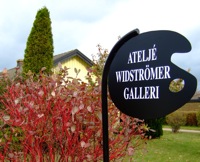Jan Widströmer

Q: Why did you decide to be a painter? And did you go to art school?
First I was encouraged by my art teacher at upper secondary school, then I was a romantic and a dreamer, who knew very little of the harsh conditions of an artist´s life. So I wanted to go to an art school in Gothenburg in the late 60´s, but dropped out before I really got in because of the political left-wing activities there. The students (and some teachers) were more interested in political meetings, manifestations and demonstrations than in traditional art class activities, which were considered 'bourgeois'. So instead I entered the University of Gothenburg to study the history of art, literature and culture, the Nordic languages and English. Finally I got a teacher´s exam.
Still I continued painting much as before. I found practical advice from handbooks and took good advice about my painting from anyone that was my better. (Meeting established artists over a pint of beer at the pub gave some education.) And of course I saw a lot of art exhibitions both in Gothenburg and Stockholm. I also travelled to see the great art museums of Europe. Otherwise I was proudly self-taught and meant that practice makes perfect.
Q: When were you established as an artist?
Throughout the 1970`s I experimented in style and developed new techniques. I also painted traditional landscapes on the side. Finally I became .a full modernist., selling off some of my landscapes and giving others away. When I paint landscapes today they look quite different. Sometimes I rather depict my experience of being there than the landscape itself.
At the same time I started writing poetry and found ways to develop the same theme in words as in my pictures. Sometimes the words came first, but it could also be the other way around. I invented my own .ism, that I called emblematism. Meaning that flat, simple figures, silhouettes and geometries, .emblems., were combined to make a picture.
When I got a job as a teacher in Falkenberg my wife and I decided to move there. I had my first solo exhibition at the local gallery there with 86 artworks, and it was a success . From then on I have exhibited my art in Sweden and abroad. You can also find my art on some sites on the internet.
Q: You have made a large series of paintings called Musical moments and another called Transcendental studies. What do these titles mean?
I have always looked up to music as the purest of art forms and I envy those that can compose great music. My ambition has been to get as close as possible to that perfection in my art. In a series of paintings called Musical moments I try to make music in color; I invite you to listen with your eyes.
In Transcendental studies my ambition is almost the same, but there I broaden .my listening. to include moments of contemplation and meditation; those paintings are meant to be more spiritual and more universal. The title means that I find my motive beyond the senses, but it also means that I translate impressions through my senses into color and form on the canvas: introvert impressionism.
Q: How do you live today? Do you make a living from your art?
I don´t teach anymore, but dedicate my full time to my art. I have a house that is a combination of living quarter, studio and exhibition hall. There my wife and I live comfortably and we welcome people to see my art.
Q: How do people react to your art today?
The funny thing is that those paintings that were considered difficult before are now popular and easily understood. It seems that time has caught up with them. On the other hand my latest experiments are still puzzling to some. But on the whole I feel more appreciated by the public today than before. Especially young people seem to understand what I´m trying to say.